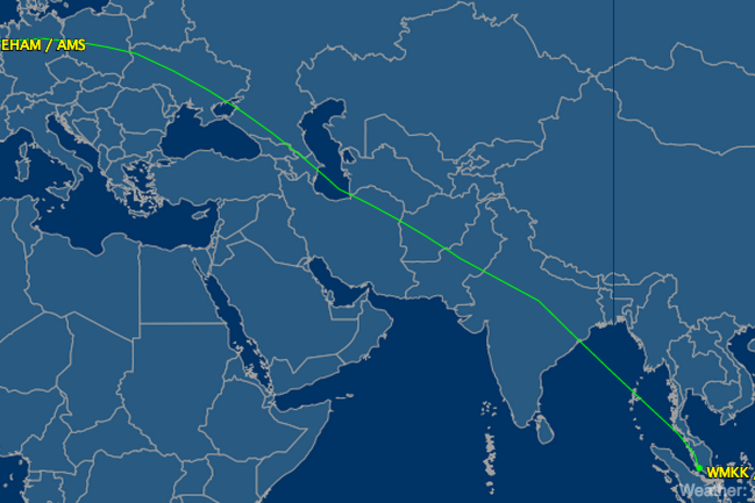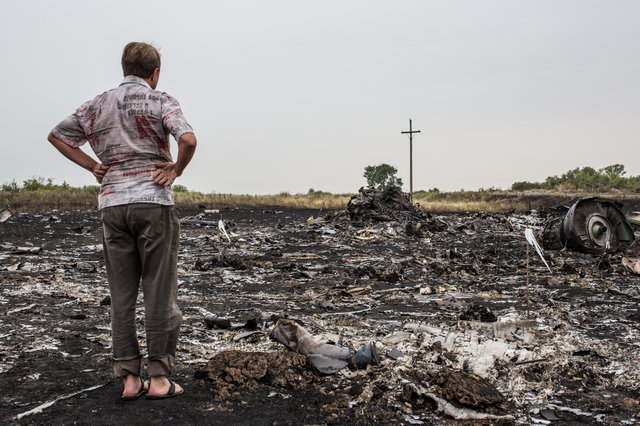MH17 Did NOT Fly Into Restricted Airspace
MH17 had been flying at 33,000 feet when it disappeared from radar at about 1.30pm local time.
The head of the International Air Travel Association (IATA) vented his frustration over the fact that MH17 was shot down despite flying what had seemed to be a safe route
"Airlines depend on governments and air traffic control authorities to advise which air space is available for flight, and they plan within those limits," said Tony Tyler, CEO of the trade association. "It is very similar to driving a car. If the road is open, you assume that it is safe. If it's closed you find an alternate route."
wsj.comThe IATA head did not assign blame to any particular authority, but with the crash of MH17, US and foreign aviation authorities have snapped into action, Vox reports
They have closed the "roads" over eastern Ukraine, telling pilots not to fly there, but it's too late for nearly 300 people. The route over eastern Ukraine was popular, as several outlets have noted, and airlines often fly over conflict zones.
 vox.com
vox.com
The MH17 incident highlights the complicated business of what are and are not safe flight paths for a civilian airliner.
 vox.com
vox.com
While the Ukrainian authorities had barred aircraft from ground level to 32,000 feet, MH17 was cruising at 33,000 feet when it was hit by a ground-to-air missile in the Ukraine
Malaysia Airlines flight MH17 was flying just 1,000 feet (300 metres) above restricted airspace when it was shot down, according to the European air traffic control body.
Though it is true that the pilot's flight path had been cleared for 35,000 feet and the plane had traveled at 33,000, it was still in what was considered a safe range, according to a NOTAM, short for "notice to airmen," sent before the plane went down.
 vox.com
vox.com
On 14 July 2014, the Ukrainian authorities issued a ban on passenger jets flying below 32,000 feet over eastern Ukraine, after some military aircraft were attacked at relatively low altitudes
On July 1, Ukraine advised pilots to not fly below 26,000 feet over the region. On Monday, Ukraine said a Russian missile took down a Ukrainian military cargo jet flying at 21,000 feet, and the government increased the restricted airspace to 32,000 feet. Aviation officials in the U.S. and Europe said they didn't know why Ukraine decided on those altitudes. Each country can issue such notices as they wish and aren't required to justify them, the officials said.
wsj.comSome observers theorized Ukraine created the no-fly zone to clear the airspace for government and military aircraft, and they limited it to still allow commercial flights above. "One, it's a hassle to block off everything. And two, you get money when people fly over you, and they wouldn't necessarily want to give up that revenue," said Mark Duell, vice president of operations for flight-tracking company FlightAware.com.
wsj.comEurocontrol, Europe's air-traffic-control organization, said on Thursday that typically about 300 flights pass over the restricted-airspace section of Ukraine
The commercial jet Malaysia Airlines flight MH17 crashed over the southeastern border of Ukraine yesterday, killing all 298 people aboard.
Image via vox-cdn.comMr. Cox, the air-safety consultant, said Malaysia Airlines shouldn't be criticized for flying just 1,000 feet above the upper limit of the restricted airspace. "If you're above the cap, you're fine," he said. "The safety margin is built into the altitude they give you."
wsj.comHowever, Thursday appeared to be the first day in July that MH17 service from Amsterdam to KL flew over the restricted-airspace region in eastern Ukraine
The previous 16 such trips that Flight 17 made in July appeared to fly just south of the restricted airspace, according to FlightAware. It was unclear why Thursday's flight appeared to have taken a more northerly route and entered that airspace.
wsj.comIATA, however, states that the airspace in which MH17 was flying "was not subject to restrictions"
Malaysia Airlines' flight MH17 was not operating in restricted airspace, according to a preliminary assessment from IATA.
Regardless of whether or not MH17 flew into restricted airspace, was flying so close to an exclusion zone that had known anti-aircraft activity an unnecessary risk taken by the carrier?
Possibly, but there are other carriers that have also operated over the same airspace regularly in the previous months, and yes, fuel savings is a major factor in route planning, as is weather. The larger issue may be the failure of the intelligence system, U.S. or otherwise, to notify international aviation authorities in each country and/or region of the fact that longer-range SAMs were now under the control of pro-Russia separatists and their level training when it comes to operating them and their associated command and control apparatus was totally questionable.
 jalopnik.com
jalopnik.com




